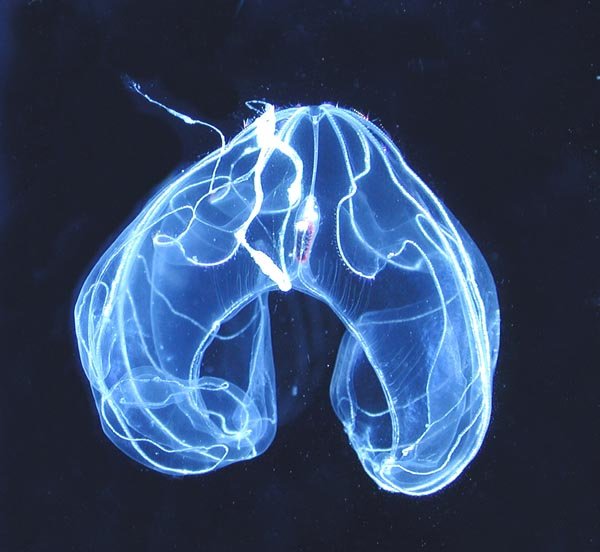The vast, uncharted world beneath the ocean’s surface continues to captivate and bewilder scientists and enthusiasts alike. With only a fraction of the world’s oceans explored, each new journey into the deep reveals wonders that ignite our imaginations and challenge our understanding of life itself. Among these wonders are creatures that look like they have been plucked from a science fiction narrative. These alien-like deep-sea inhabitants remind us of how much we still have to discover. Here, we explore 10 newly discovered deep-sea creatures that seem to have come from another planet.
Abyssal Comb Jelly

The Abyssal Comb Jelly, known scientifically as *Bathocyroe fosteri*, is a gelatinous marvel that resides in deep ocean waters where sunlight never penetrates. Its transparent body is adorned with iridescent rows of cilia that shimmer as it gracefully drifts through the abyss, resembling a mythical creature from a sci-fi movie. This comb jelly’s unique appearance aids in its camouflage against predators, blending seamlessly into the inky darkness of its habitat.
Scale Worm

With a name as unassuming as the Scale Worm, one might not expect to find an alien-like creature, yet this little-known polychaete defies expectations. These segmented worms exhibit vibrant, metallic scales that ward off would-be predators. Found dwelling in hydrothermal vent communities, they possess remarkable adaptability, thriving in extreme temperatures and pressures that would crush most living organisms.
Deep-Sea Anglerfish

Perhaps one of the more infamous denizens of the deep, the Deep-Sea Anglerfish is notorious for its grotesque appearance and eerie hunting strategies. Female anglerfish are equipped with a bioluminescent lure that protrudes from their heads, which they use to attract prey in the pitch-black waters. Their enormous mouths and expandable stomachs are evolutionary adaptations for a life where meals are scarce.
Glass Octopus

The Glass Octopus, also known as *Vitreledonella richardi*, is a true masterpiece of translucence, almost invisible in its oceanic environment. Lacking pigment, this octopus displays an ethereal glow, making its internal organs and nerves visible through its skin. This transparency serves as a defense mechanism, rendering it nearly invisible to predators in the open ocean.
Goblin Shark

Known as a “living fossil,” the Goblin Shark boasts a lineage that dates back some 125 million years. Distinguished by its elongated snout and protruding jaws packed with nail-like teeth, this predator slowly patrols the ocean depths. Its peculiar appearance is accentuated by a fleshy pink hue, contributing to its terrifying visage—one that wouldn’t seem out of place in a horror film.
Barreleye Fish

The Barreleye Fish presents another startling example of evolutionary ingenuity. Its most distinguishing feature is its transparent head, which houses large, upward-pointing eyes. This unique adaptation allows them to detect the faintest glimmers of sunlight or bioluminescence from prey above, while simultaneously offering protection from the pressures of deep-sea living.
Zombie Worm

Aptly named, the Zombie Worm exhibits a macabre diet. These fleshless scavengers feast on the bones of whale carcasses, extracting nutrients through symbiotic bacteria in their bodies. More formally known as Osedax, these worms have developed interesting reproductive strategies—dependent males live within the larger females, ensuring a steady supply of offspring.
Yeti Crab

The Yeti Crab is an astounding crustacean that thrives near hydrothermal vents. With its distinctive furry pincers and thorax, it cuts a striking figure against the dark seabed. These “furs” are actually colonies of bacteria, which the crab farms, providing a constant source of sustenance—an unusual relationship that reflects the intricate interdependencies of deep-sea life.
Pelican Eel

The Pelican Eel captivates observers with its remarkable features. Unlike any other eel, it can unhinge its jaw to form a massive pouch—reminiscent of a pelican’s beak—allowing it to consume prey much larger than itself. As masters of stealth, they remain elusive in the dark waters, expanding our sense of what is possible under the sea.
Frilled Shark

The Frilled Shark rounds out our list as another remnant from prehistoric oceans, with a serpentine body and rows of needle-like teeth lining its mouth. Its bizarre appearance and primitive features underscore the mysterious expanse of the deep-ocean environment. They are rarely glimpsed by humans, leaving much about their behaviors and life cycle cloaked in mystery.
In conclusion, the deep sea remains a final frontier filled with creatures that defy our wildest imaginations. These newly discovered deep-sea inhabitants, with their alien-like appearances and extraordinary adaptations, remind us that our planet still holds countless secrets waiting to be uncovered. As exploration technology advances, we anticipate more revelations that will further blur the lines between the familiar and the fantastical in our understanding of life on Earth.




